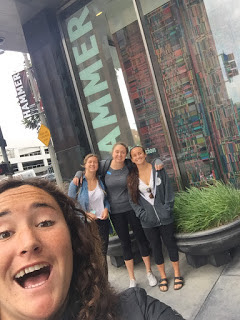 For my fourth event I attended an on campus lecture “Replica Praesens: A Lecture on Synthetic Life by Sam Wolk." Wolk’s project was a computer system he created that looked into genetics of plants/nutrients and creatures, how they interact, depend on each other, and daily lifestyles. He started by introducing the nutrients to the audience with a red, blue and green scale which represent different nutrients and the darker they were this meant that they were more beneficial to the creatures. He showed how each was selected by arranging the DNA into different combinations. Through simulations after this that would represent a timeframe that the plants would grow over was interesting to see how the pieces before factored into the location, lifespan, nutrient denseness, and size of the plants.
For my fourth event I attended an on campus lecture “Replica Praesens: A Lecture on Synthetic Life by Sam Wolk." Wolk’s project was a computer system he created that looked into genetics of plants/nutrients and creatures, how they interact, depend on each other, and daily lifestyles. He started by introducing the nutrients to the audience with a red, blue and green scale which represent different nutrients and the darker they were this meant that they were more beneficial to the creatures. He showed how each was selected by arranging the DNA into different combinations. Through simulations after this that would represent a timeframe that the plants would grow over was interesting to see how the pieces before factored into the location, lifespan, nutrient denseness, and size of the plants.
Next we moved onto see how the DNA process worked for the creatures. I thought it would be similar, but there were many characteristics that were different because of the creatures complexity. One example is how the sex of the creature is determined which I found interesting, multiple creatures could be involved and it seemed that the gender of the offspring was much more random than it would be.
Then he brought the two together into a world and we watched as they interacted with each other. As this was going on I was comparing it to video games in my heads, but this project was so much more and you could tell by listening to all of the details while Sam Wolk spoke. The amount of time he spent connecting assets of life into a computer programming system to visually represent life was very cool. It interested me in how he was able to create these connections just from writing out codes and making them represent something much bigger and influential.



















